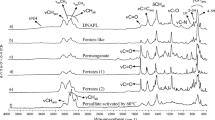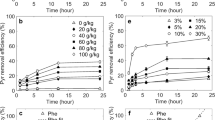Abstract
The feasibility of degrading 16 USEPA priority polycyclic aromatic (PAH) hydrocarbons (PAHs) with heat and Fe(II)-EDTA catalyzed persulfate oxidation was investigated in the laboratory. The experiments were conducted to determine the effects of temperature (i.e. 20 ∘C, 30 ∘C and 40 ∘ C) and iron-chelate levels (i.e., 250 mg/L-, 375 mg/L- and 500 mg/L-Fe(II)) on the degradation of dissolved PAHs in aqueous systems, using a series of amber glass jars as the reactors that were placed on a shaker inside an incubator for temperature control. Each experiment was run in duplicate and had two controls (i.e., no persulfate in systems). Samples were collected after a reaction period of 144 hrs and measured for PAHs, pH and sodium persulfate levels. The extent of degradation of PAHs was determined by comparing the data for samples with the controls.
The experimental results showed that persulfate oxidation under each of the tested conditions effectively degraded the 16 target PAHs. All of the targeted PAHs were degraded to below the instrument detection limits (∼4 μ/L) from a range of initial concentration (i.e., 5 μ/L for benzo(a)pyrene to 57 μ/L for Phenanthrene) within 144 hrs with 5 g/L of sodium persulfate at 20 ∘ C, 30 ∘C and 40 ∘C. The data indicated that the persulfate oxidation was effective in degrading the PAHs and that external heat and iron catalysts might not be needed for the degradation of PAHs.
The Fe(II)-EDTA catalyzed persulfate also effectively degraded PAHs in the study. In addition, the data on the variation of persulfate concentrations during the experiments indicated that Fe(II)-EDTA accelerated the consumption of persulfate ions.
The obtained degradation data cannot be used to evaluate the influence of temperature and Fe(II) levels on the PAH degradation because the PAHs under each of the tested conditions were degraded to below the instrument detection limit within the first sampling point. However, these experiments have demonstrated the feasibility of degrading PAHs in aqueous systems with persulfate oxidation. Additional tests are being conducted to evaluate the effectiveness of treating PAHs in soils and obtaining the rate of degradation of PAHs with persulfate oxidation.
Two sets of laboratory experiments were conducted to evaluate the ability of sodium persulfate in oxidizing real world PAH-contaminated soils collected from a Superfund site in Connecticut. The first set of soil sample were treated only with persulfate and to the second batch, mixture of persulfate and Fe(II)-EDTA solutions were added. The results of the second test showed that within 24 hours, 75% to 100% of the initial concentrations of seven PAH compounds detected in the soil samples were degraded by sodium persulfate mixed with FE(II)-EDTA.
Similar content being viewed by others
References
Adanti, D. and Michelini, J.: 2005, ‘Treatability Study: Application of Persulfate Chemical Oxidation Technology on the Polycyclic Aromatic Hydrocarbons at a Superfund Site in Eastern Connecticut.’, Senior Design Project submitted to the Department of Civil and Environmental Eng, at the University of Connecticut.
Cuypers, M. P., Grotenhuis, J. T. C. and Rulkens, W. H.: 1999, ‘Prediction of PAH Bioavailability in Soils and Sediments by Persulfate Oxidation’, Proceedings of the International in Situ and On-Site Bioremediation Symposium, 5th, Editors: Bruce, C., Leeson, A., San Diego, CA, USA, 8 241–246.
Cuypers, C., Rina, C., Grotenhuis, T. and Rulkens, W.: 2001, ‘Prediction of Petroleum Hydrocarbon Bioavailability in Contaminated Soils and Sediments’, Soil and Sediment Contamination, 10(5), 459–482.
Cuypers, C., Grotenhuis, T., Joziasse, J. and Rulkens, W.: 2000, ‘Rapid Persulfate Prediction Bioavailability in Soils and Sediments’, Environmental Science and Technology, 34(10), 2057–2063.
Grotenhuis, T., Hendriks, W., Dijkhuis, E., Van der Gun, J., Doze, D. and Pancras, T.: 2001, ‘Determining Processes Related to in-situ Remediation of Contaminated Sediment’, Proceedings of the International in Situ and On-Site Bioremediation Symposium, 6th, Editor: Leeson, A., San Diego, CA, USA, June 4–7, 5 289–296.
Peyton, G. R., LeFaivre, M. H. and Smith, M. A.: 1990, ‘Treatability of Contaminated ground Water and Aquifer Solids at Town Gas Sites’, using Photolytic Ozonation and Chemical in Situ Reclamation, Illinois State Water Serv. Div., Champaign, IL, USA, Report HWRIC-RR-048.
Author information
Authors and Affiliations
Corresponding author
Rights and permissions
About this article
Cite this article
Nadim, F., Huang, KC. & Dahmani, A.M. Remediation of Soil and Ground Water Contaminated with PAH using Heat and Fe(II)-EDTA Catalyzed Persulfate Oxidation. Water Air Soil Pollut: Focus 6, 227–232 (2006). https://doi.org/10.1007/s11267-005-9008-z
Received:
Revised:
Accepted:
Published:
Issue Date:
DOI: https://doi.org/10.1007/s11267-005-9008-z




